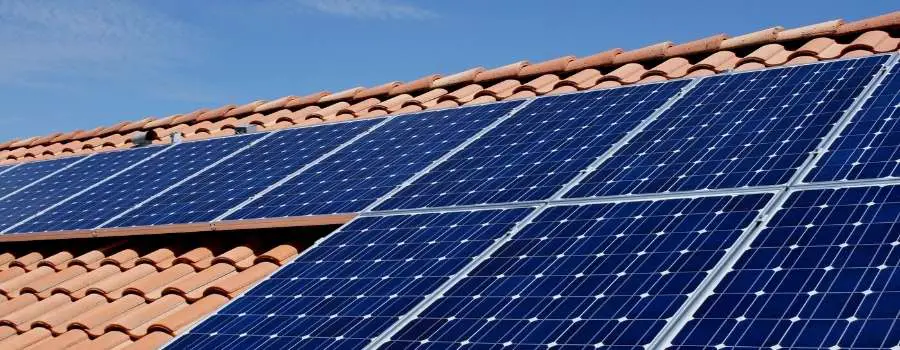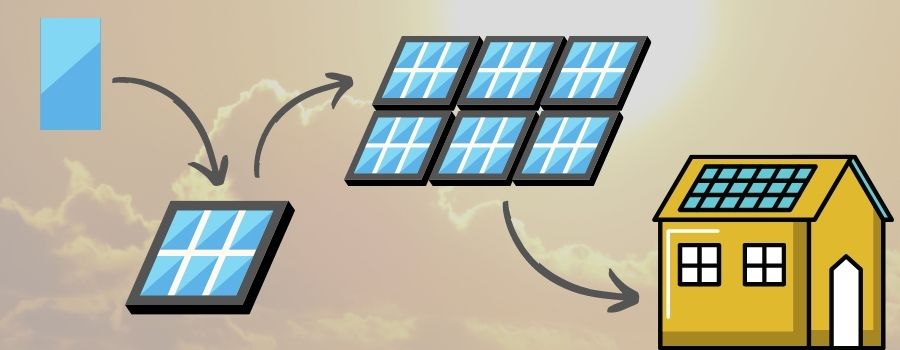
If you’re considering installing solar panels, you may have heard of the terms “photovoltaic cells” and “solar panels.” But what are the differences and similarities? Since the terms are used interchangeably, I thought I’d dig into the details a bit more to help ease the confusion some new comers to solar power may experience.
What Is The Difference Between Photovoltaic And Solar Panels?
In general, the difference between photovoltaic and solar panels is that photovoltaic cells are the building blocks that make up solar panels. Solar panels are made up of many individual photovoltaic (PV) cells connected together.
Many people will use the general term “photovoltaic” when talking about the solar panel as a whole. The solar panel itself is made up of, in addition to photovoltaic, but also plastic and metal framing, wiring, and glass.
Likewise, the term “solar panel” is used as a blanket term for the entire panel…even if someone is specifically talking about photovoltaic cells. Similar to if someone says “my car engine needs repairs,” even if they specifically mean the alternator or the battery.”
Are Solar Panels And Photovoltaic The Same Thing?
While photovoltaic cells are used in solar panels, the two are distinctly different things. Solar panels are made up of framing, wires, glass, and photovoltaic cells, while the photovoltaic cells themselves are the basic building blocks of solar panels.
Photovoltaic cells are what make solar panels work. The photovoltaic cells take the sunlight and turn it into electricity that can be used to power your home or business.
There are two types of photovoltaic systems:
- Monocrystalline
- Poly-crystalline.
Monocrystalline
Monocrystalline photovoltaic cells are made of a single, large crystal of silicon. They are cut from a cylindrical ingot of crystalline silicon.
The advantage to monocrystalline cells is that they are very efficient at converting sunlight into electricity. The downside is that they can be more expensive than polycrystalline cells, as a result, you’ll usually see monocrystalline used in higher-end solar panels.
Polycrystalline
Polycrystalline photovoltaic cells are made of many small crystals of silicon that are cast from a rectangular silicon ingot.
The advantage to polycrystalline cells is that they are less expensive to manufacture than monocrystalline cells. The downside is that they are not as efficient as monocrystalline cells at converting sunlight into electricity. You’ll usually find polycrystalline in products like solar-powered calculators and small solar lights.
How Do Photovoltaic Cells Work?
Photovoltaic (PV) cells are made of two or more layers of semiconductor material, most commonly silicon. When PV cells are exposed to sunlight, they create an electrical field across the layers. This causes electrons to flow through the silicon PV cell, creating direct current (DC) electricity.
The photons from the sun knock electrons loose from their atoms. This process of freeing electrons is called the “photoelectric effect.” When these free electrons flow through the material, they create an electric current.
PV cells are connected together in modules that make up solar panels. The modules are then connected to an inverter that changes the DC electricity produced by the PV cells into alternating current (AC) electricity, which is the type of electricity used in your home.
Solar panels are connected together in arrays to produce enough electricity to power your home or business.
How Does It All Fit Together?
To bring it all back together, the broadest way to think about it is to start with a solar photovoltaic cell. Many of these cells are put together to make up a solar panel.
Solar panels are then connected together in arrays to create enough power for your home or business. The solar inverter changes the direct current (DC) electricity produced by the PV cells into alternating current (AC) electricity, which is the type of electricity used in your home. Power is stored in batteries to be used in your home as needed.

Photovoltaic Cell =====> Solar Panel =====> Solar Array =====> Powers Your Home
What Else Contains PhotovoltaicCells?
In general, photovoltaic cells are going to be used in anything that needs to convert sunlight into electricity. In addition to solar panels, photovoltaic cells are found in everything from calculators to solar lighting to spacecraft.
In addition to solar panels, there are other products that contain photovoltaic cells, such as:
- Solar Shingles
- Solar Backpacks
- Solar Tiles
- Solar-Powered Calculators
- Solar Window Film
- Solar Bags
- Solar Lights
- Spacecraft
- Some Automobiles
There are also new technologies being developed to help bring solar energy to the masses. In the near future we won’t be limited to just solar panels to harness energy from the sun. Things such as photovoltaic paint, solar skins, and many other innovations are being researched.
Can Solar Power Be Made Without Photovoltaic Cells?
According to US physicists, it’s possible to generate solar energy without solar cells using an optical battery. This concept would utilize the conversion of energy inside insulators instead of semiconductors, may offer a less expensive alternative energy source than current solar-cell technologies.
The research is still in its early stages, with a working prototype yet to be built. But the team believes that an optical battery could become a reality within five to ten years.
The biggest draw back with this technology currently is that the amount of light that would need to be focused is astronomically high, theorized at 10 million watts per square centimeter…a feat that is still a ways off from being attainable, if ever!
So, as of now, there is no way to produce adequate solar energy without the use of photovoltaic cells. It’s been the technology of prominence for decades and it looks like that’s not changing any time soon.
Final Thoughts
Though solar power can be made without photovoltaic cells, the technology is still in its early stages and has a ways to go before it becomes a viable alternative energy source.
Photovoltaic cells are currently the best way to convert sunlight into electricity, and they will likely remain that way for some time. Though other technologies are being developed, they are not yet able to produce solar energy on the same scale as photovoltaic cells.

